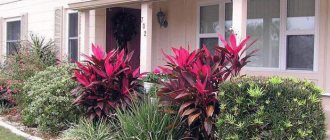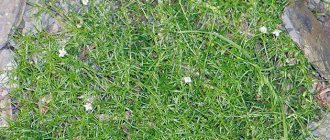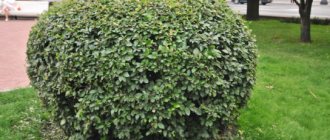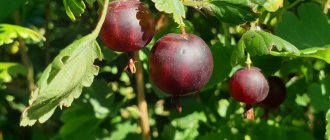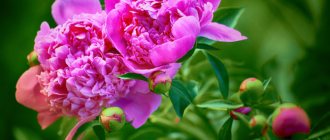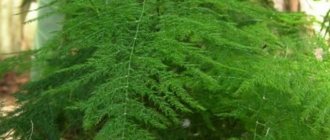Conifers are evergreen woody plants covered with needles, which from a botanical point of view are foliage (needle-shaped, lined or scaly). These include araucaria, spruce, kauri, cedar, cypress, larch, juniper, fir, sequoia, pine, yew, thuja and others.
Due to their unpretentiousness, year-round greenery and aesthetic appearance, they have long been actively used by site owners to create a unique landscape design. Decorative coniferous shrubs are especially popular - low, voluminous and pleasing to the eye.
Tall
Stately tall coniferous trees are not just a decoration for a personal plot, but also a natural barrier from prying eyes, dirty air and dust.
Prickly spruce Glauka
Everyone will like the ideal shape of the Glaucian cone - it is so clear and beautiful that it looks amazing both separately and in a series of similar ones. Young needles are green, later acquiring a pleasant blue tint. The height of an adult conifer reaches 12-15 meters, the lower branches can grow up to 4 m in length.
Therefore, this prickly spruce is suitable exclusively for spacious areas.
Blue Mountain spruce
Another bulky blue spruce, not inferior in size to Glauka (15 m high, 8 m wide). Grows quickly (30-35 cm per year). Several coniferous trees in a row are an effective natural filter from dirty air. It is better to plant in the sun: a high level of insolation allows you to achieve and maintain the beautiful blue tone of prickly spruce needles.
Black pine Pinus
In the wild, black pines reach 50 meters in height; on the site, their growth most likely will not exceed 15-25 m. The dark matte needles are denser than those of ordinary pine, which makes Pinus a suitable option for creating shade in the right place on the site. The ephedra will grow well in a sunny place; before planting, it is advisable to ensure good drainage.
European larch Larix
A powerful straight trunk, a symmetrical cone-shaped shape, neutral green needles - this larch will look good on any site. The needles of the conifer are bright, turn yellow in the fall, fall off in the winter, and in the spring the luscious foliage appears on the branches again.
Larix loves light, easily survives frosts, and is not picky about the composition of the soil. The only thing is that in order for the plant to feel good, it should not be over-watered.
Korean fir Abis
This coniferous tree takes root well in the middle zone, so it is one of the most popular options among owners of private houses and summer cottages. The crown is cone-shaped and forms without pruning, but every year it is recommended to carry out preventive removal of dry branches.
It is better to cover young growth for the winter, it is advisable to drain the soil - Abis does not like dense soil.
Peculiarities
When deciding to plant coniferous shrubs on your site, it is useful to get acquainted with some of their features in advance in order to skillfully fit them into the landscape of your garden.
Tree or bush
In nature, most conifers are trees. They are distinguished by a spreading crown, a strong trunk, and a powerful root system. Such handsome giants are not particularly suitable for landscape design, because they create a lot of shadow and do not fit into the miniature size of the garden plot. The ball problem was solved in two ways.
Firstly, special ornamental coniferous shrubs, characterized by their small height, were bred. For example, no one will doubt that the mighty tall pine is a tree. However, look at its individual varieties - the bright Golden Glow lantern, the short and thick Gnome, the fluffy ball of Watereri. Also, no one will doubt that these are exactly shrubs - low, neat and incredibly stylish.
Decorative pine varieties:
Secondly, if the same tree is regularly pruned without allowing it to grow in height, it can begin to branch heavily and spread out in width, turning into a bush.
Advantages
Why are shrubby conifers so popular in landscape design? Why are many owners of country houses, garden plots and country houses so eager to acquire them? The advantages are obvious:
- hardy;
- unpretentious;
- needles that are expressive with their persistent and bright color;
- frost-resistant (most of them);
- allowing you to shape your silhouette as needed to create a pattern in a flowerbed;
- multifunctional;
- good for health (they release phytoncides into the air);
- drought-resistant;
- undemanding to soil type.
And, of course, evergreen shrubs are chosen to decorate plots because they delight the eye with their greenery all year round, enlivening them and taking part in creating flower beds of continuous flowering.
Functions
Coniferous bushes are simply irreplaceable in landscape design. They help create multi-style garden compositions and can become:
- a point of attraction on wide lawns;
- an essential element of rock gardens and rockeries;
- a classic shading background for flower beds of bright flowers;
- division into sectors and zones;
- decor for stones, buildings and fences;
- hedge;
- decorating flowerpots;
- good neighbors for some garden plants (for example, heather).
The main thing is to know exactly where to plant them and what to combine them with so that they become a decoration of the garden, and not a useless heap.
Accommodation Tips
To make a site with coniferous shrubs a real work of art, you can use the advice of landscape designers:
- if you create a flowerbed from only dwarf shrubs, it will fit perfectly into the design of a spacious lawn;
- Low-growing shrubs can be planted near the borders;
- for ponds on the site it would be good to create an edging with alternating conifers and deciduous weeping trees;
- plants with wide, variegated, curly leaves are planted surrounded by low coniferous bushes, which serve as an excellent shading background;
- low-growing varieties of pines are combined with creeping perennial plants and ground cover junipers;
- to create contrast, coniferous bushes are planted next to container nandinas and barberries;
- in alleys they look good when alternating with deciduous shrubs;
- junipers are used as hanging plants and in tandem with ferns.
Since coniferous bushes are easily modeled using pruning and take the desired silhouette and shape to fit into the created composition, they often become examples of real topiary art.
Creeping
For many, conifers are stately, tall trees. As a last resort - small neat bushes. But the family also contains no less spectacular creeping species.
Juniper horizontalis Prince of Wales
Horizontal junipers are wonderful green carpets that grow up to 1.5 m in diameter. At the same time, the height of an adult plant is a maximum of 10 cm. The Prince of Wales variety has a crown that changes color: in summer it is juicy green, closer to winter the needles darken to a purple tone.
This conifer is planted in a well-lit place, protected from overflow. Otherwise, the variety is undemanding and non-capricious.
Spruce Lorelei
In general, Lorelei is a rare “weeping” variety of coniferous trees. But since spruce grows slowly, during the first years of its life it really resembles a creeping shrub. Grows well in acidic soils without stagnant moisture, and is not afraid of severe frosts. Unpretentious to the sun. Since the shoots are hanging, a garter may be required.
Cross-paired microbiota
A close relative of the cypress, it is not without reason that it is loved by gardeners and landscape designers. The microbiota is absolutely undemanding to planting conditions and care. Will survive both harsh winters and hot summers. Favors haircuts.
Flexible strong branches can withstand not only wind, but also heavy snow. The height of an adult plant is no more than 50 cm. Thanks to the branches pointing down, it looks creeping.
Juniper medium Gold Kissen
Conifers are not only green or blue, but also golden! Charming green-yellow needles make Gold Kissen a bright accent in any mixborder. The shrub for the most part does not grow upward (maximum 100 cm), but sideways, reaching a 2.5-meter paw span.
Norway spruce Nidiformis
This spruce has the same dimensions as the previous juniper, but differs from it in color - it is green, and in needles - needles instead of scales. Due to the abundant growth on the sides and small height, Nidiformis really looks creeping, representing a voluminous pad.
Kinds
There are different types of coniferous shrubs that can be used for the garden. Here you will find several classifications and names of plants.
Depending on height
Short:
- mountain pine Golden Glow (Golden Glow) - 0.5 m;
- common spruce Maxwellii (Maxwelli) - 100 cm;
- juniper horizontal Blue Chip (Blue Chip) - 35 cm;
- blunt-leaved cypress Aurora (Aurora) - 65 cm;
- microbiota cross-paired Jakobsen (Jacobsen) - 70 cm.
Medium height:
- mountain pine Gnom (Gnome) - 1 m;
- prickly spruce Glauca Globosa (Glauca Globosa) - reaches 3 m by 30 years;
- Chinese juniper Mint Julep (Mint Julep) - 2 m;
- blunt-leaved cypress Rashahiba (Rashahiba) - 2 m;
- yew berry Elegantissima (Elegantissima) - 2 m.
Tall:
- Scots pine Watereri (Wateri) - 4 m;
- blunt-leaved cypress Draht (Draht) - 3 m;
- yew berry Hicksii (Hixie) - 4.5 m;
- cryptomeria japonica Elegans Viridis (Elegans Viridis) - 4 m.
If you need to decorate a border or highlight a garden path, it is better to take a low-growing coniferous shrub. Medium-sized ones are suitable for decorating flower beds and more serious flower arrangements. Tall ones are used in landscape design as hedges or points to attract attention in spacious lawns.
Depending on sunlight tolerance
Shade-loving and shade-tolerant (sciophytes and scioheliophytes):
- fir;
- spruce;
- cedar, etc.
Photophilous (heliophytes):
- pine;
- larch.
Most coniferous shrubs are shade-loving, grow well in the shade and do not require a constant stream of ultraviolet light. Only two species are classified as light-loving: pine and larch. So it is better to plant their decorative varieties in sunny areas. They can be recognized by their light colored needles. All the rest are dark coniferous.
Depending on the shape
Pyramidal and round shrubs look most beautiful in the garden.
Globular:
- mountain pine Pumilio;
- black pine Spilberg;
- Thuja occidentalis Little Gem, Globosa, Hoseri, Mirjam, Mr. Bowling Ball, Teddy, Tiny Tim or Danica;
- juniper: Chinese Echiniformis, scaly Blue Star, scaly Floreant, common Berkshire.
Pyramidal:
- rock junipers: Blue Arrow (blue pencil), Skyrocket, Moonglow;
- common junipers: Hibernica, Arnold, Compressa, Sentinel;
- Chinese juniper Keteleeri;
- yew berry Fastigiata, Fastigiata Aurea;
- Thuja occidentalis Bobeck's Tower, Holmstrup, Degroot's Spire;
- single color fir Fagerhult.
Many coniferous shrubs can be given any shape using decorative pruning.
Depending on brightness
When organizing flower arrangements and flower beds on your site, you should consider how shrubby conifers will fit into them in terms of their color.
Firstly, as already mentioned, there are two light-coniferous plants - larch and pine. The rest are dark coniferous.
Secondly, many are interested in flowering coniferous shrubs, although this name is not entirely correct from a scientific point of view. Cones are taken for flowering in this type of plant. For some, they are so beautiful and have an unusual shade that they are as close to flowers as possible. First of all, these include juniper varieties. Among them you can find a very different palette - from bright yellow to blue.
Thirdly, in the second half of summer, closer to autumn, some conifers form fruits on their branches that attract attention with their bright color. For example, a well-known shrub with red berries is the berry yew. Or the same juniper, whose flowers turn into small bluish fruits. Such options will fit perfectly into flower beds of continuous flowering.
Care instructions
Those who have carefully studied the descriptions of the species already know that minimal care is needed for conifers:
- Watering. Additional moisture is required only in the first couple of years after planting, after which the plant can feed on its own.
- Feeding. They apply it once every 2-3 years (the older they are, the less often), but they begin to fertilize from the second year of life in a permanent place.
- Mulching. A layer of sawdust, peat or bark will protect the soil from excessive evaporation of moisture, suitable for moisture-loving conifers.
- Trimming. Not all varieties need pruning: mainly dwarf or creeping species should be pruned. This is done once a year, the most favorable time is March. Sanitary pruning is carried out as necessary, removing dried branches.
Basic conditions for coniferous shrubs
Coniferous bushes can overwinter without shelter, but should not be exposed to the wind during the winter months. And also you should not expose them to direct sunlight. They should not be over-watered or over-dried. They grow well in almost any soil except swampy soil.
Coniferous shrubs are recommended to be used to create green walls and hedges, but they are not recommended to be planted near rocky paths or close to houses. At the same time, coniferous plants should not be planted in the shade so that they do not lose their decorative appearance when choosing a plant variety.
You should take into account how much light there is in the planting area, what kind of soil there is, and how well they fit in with other plants in the flowerbed. The climate and type of landscape composition are also important.
Examples of use in landscape design
In the design, it is advisable to combine conifers that differ in size, type and color. Yellow juniper, blue spruce, and green cypress coexist perfectly in one composition.
Bright representatives of the “needle-shaped” can coexist with any other plants, representing the decoration of a flower bed or rock garden.
Important! Conifers look great surrounded by stones.
And lastly, tall spruces, pines, and larches can act as a beautiful backdrop for flowers or garden figurines. For these purposes, take fast-growing varieties.
Choose conifers for your dacha from the 15 listed, combine them with each other or use them as a free-standing decoration on your site.
Selection of shrubs
In landscape compositions, spruce and pine trees look quite impressive. Don't be afraid of their large size and bulkiness. For decades they will not grow more than 200 centimeters. Dwarf shrubs do not have branched roots that lie deep.
To create a hedge, it is better to plant the prickly spruce Picea pungens. If the interval between trees is maintained at 100 centimeters, a hedge of green spaces is formed as the plant grows. But it should not be used to decorate New Year's holidays.
To decorate the area, you can use mixborders of shrubs and conifers, planting bushes of different heights.
A gardener can always choose among thousands of varieties of trees and shrubs. In order not to spend too much, you can buy seedlings of ordinary coniferous shrubs, not dwarf ones, and prune them. These plants can be divided into several types: microdwarfs (reach 30 mm), mini-dwarfs (up to 80 mm), dwarfs (from 15 to 20 centimeters).
And there are also taller varieties: semi-dwarf from 25 to 35 centimeters, medium-sized (reach half a meter), full-sized (grow 30 centimeters per year, in ten years they can grow up to three meters).
Dwarf shrubs can be grown in a regular flower pot. In summer, you can put such plants in a flower garden or grow them in alpine hills. Particularly heat-loving conifers must be taken home or into a greenhouse with the arrival of winter.
How to decorate a garden
There are several techniques you can use to decorate your site:
- Combination with other plants. Conifers are harmonious with large flowers and plants with decorative leaves, for example, rhododendrons. This composition can be changed every season by selecting new plants. It is not recommended to plant birch and bird cherry next to bushes;
- Alpine slides and ponds. In such a composition, it is important to think over the color scheme, taking into account the fact that many plants change shades in the fall. Tall, spreading bushes should be planted in the background, and creeping and low-growing varieties should be planted in front;
- Hedge. Several conifers planted nearby will help to delimit the area into zones or cover an unnecessary area. The best plant shapes for this design: pyramid, ball, column. Dwarf plant species are suitable for creating a living border;
- Accent. To emphasize any zone on the site, you can plant a single coniferous bush or bonsai;
- Group plantings. This type of landscape design should be based on the similarity of shapes, colors, and sizes. When planting, it is important to consider the approximate height and volume of each adult plant.
Currently reading:
- Planting to decorate the site with three types of coniferous trees
- Persistent, large harvest of cucumbers after planting them as seedlings
- Basic technologies for growing and caring for peas
- Effectively getting rid of whiteflies on plants
Share the news on social networks
About the author: Victoria Semyonovna Nakhodkina
Leading researcher at the laboratory of vegetable and berry crops, Yakut Scientific Research Institute of Agriculture, Siberian Branch of the Russian Academy of Agricultural Sciences, Republic of Sakha (Yakutia).
How to plant ephedra correctly
For shrubs, select places where the wind does not blow and the sun's rays do not burn them. Gardeners should purchase seedlings from nurseries in your region. Such plants are better adapted to the climate and take root easily.
The shrub should be planted in spring; a drainage layer should be made at the bottom of the hole and the interval between nearby plants should be at least one and a half meters. In this case, the root collar is not buried. Ephedra requires abundant watering at least once every seven days. In winter, it is better to cover the root system.
It is recommended to plant junipers or dwarf pine in sandy soil. High humidity is common for metasequoia or thuja. Yew and microbiota prefer shaded areas.
Before planting a plant, you should understand what height and volume the shrub will reach. Gardeners often sin by planting them too close to each other and this prevents the seedlings from growing. Then the conifers begin to outlive each other from the area, their decorative appearance deteriorates, and this area of the garden becomes too shaded.
When purchasing, you should choose seedlings with a ball of earth; they can be sold in containers. You should not buy shrubs that have open roots, because the plant looks impressive; the lateral shoots have already begun to die off. When such a plant is planted, it dies within two years.
Plants should not be buried deeper than the height that was in the container when the seedling was sold.
Planting should be done in April or May, but this should not be done in the autumn months, because the ephedra does not have time to adapt and take root. Shrubs should not be planted on hot days or in strong winds. In such weather, their roots dry out. It is better to plant the most heat-loving shrubs in a place where there is no strong wind in winter. Otherwise, they may freeze out.



